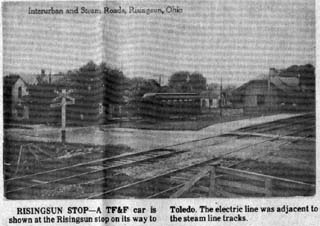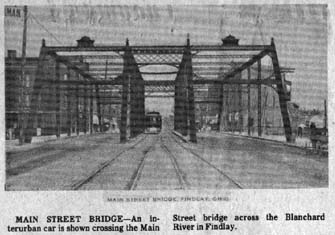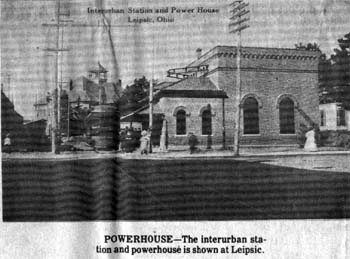May 18, 1977



Picture #1 – Risingsun Stop – A TF&F car is shown at the Risingsun stop on its way to Toledo. The electric line was adjacent to the steam line tracks.
Picture #2 – Main Street Bridge – An interurban car is shown crossing the Main Street bridge across the Blanchard River in Findlay.
Picture #3 – Powerhouse – The interurban station and powerhouse is shown at Leipsic.
EDITOR’S NOTE: This is the last installment in a series of three about the electric interurban era as it existed in Fostoria and surrounding areas. If readers have additional data or photos they would like to donate to the editor’s file on this subject, please write c/o Review Times.
In addition to the passenger traffic, the electric lines hauled a lot of freight. Some of the passenger cars had a baggage area to accommodate freight. There were also strictly freight cars.
Piggyback service, prevalent in today’s railroad system, was in use when the electric lines existed. They too had large shipping containers that were slid onto flatbed cars and moved from town to town.
It took a lot of people to operate the interurbans. On the TF&F line, in addition to E. Smith as general manager, there was Ross Ewan, accountant; John Mitchell and Rollie Ford, master mechanics; Miss Buschman (later Mrs. Fred Trudal) bookkeeper; Frank Kinker and Maurice Gray, freight agents; Earl Mitchell, motor repairman.
Dispatchers were August Wilson and Grant Warden.
Conductors were Howard Cochard, Fred McCormick, Howard Hallman, Clifford Gray, Mr. Hastings, John Siveus, Bert Hanley, Clarence Cramer, Obediah Crow, Otto Crow, Mr. Brentlinger, Dewey Church, and Orin Goodman. Motormen were Bert McClellen, Charles Zuelske, Otto Hummel, George Lamson, Bert Crain, John Comer, Harry Heller and Ray Henline.
Track and line maintenance: John Snyder, superintendent, Alva E. Lytle, Charles Snyder and Ed Knepper, foremen; Fred Butzier, Howard Butzier, Clarence Vanderhoff, “Nicey” Rinebolt, Dewey Monroe, Archie Monroe, Denver House, Jack House, Marion Kimble, Wesley Peirce, James Morris, work car and line foreman. Car hostlers were Jud Gray and Bill Mosier, “Pat” and “Mike” Smith, sons of E. Smith, filled in wherever their dad directed.
The only names I have been able to uncover for the FF&F are Harry Frankenfield, Bert Zimmerman, Roy Shoupe, all of which were either motormen or conductors.
On the old TF&E, I distinctly remember Mr. Corregan, who was conductor, and there was a Mr. Glick who served as motorman.
There are probably many more names that could be associated with the three electric lines that served Fostoria, but at this point in time it is extremally difficult to collect them.
Of all those men who were employed by the TF&F, only seven are still living as far as it has been determined…they are Ray Henline, Denver House, Otto Crow, Clarence Vanderhoff, Orin Goodman, “Pat” and “Mike” Smith.
Esther Wendt reminded me that it was not all glamour for the conductors and motormen…they worked 10 hours a day; seven days a week. Also, they had to walk to the car barns on Findlay Road to start their daily runs.
“On the other hand”, she said, “they were often rewarded by country folks along the line for dropping off town purchases as they passed by…a dressed chicken or fresh vegetables”.
Mrs. Wendt’s father, John Comer, started for the TF&E. He helped build the line as well as tear it up. He also worked for the TF&F.
Looking back on that era, and at the usefulness of the electric lines, it seems that they should have existed longer. But according to the data, and the fact that by approximately 1930 they were “gone”, is strong evidence that they could not maintain the competitive position they had initially.
Some of the investors in the electric lines poured additional capital into the systems to make a last ditch stand. They put on bigger and better cars. Some of them equipped their lines with cars that had “parlor” areas, in which there were overstuffed davenports and lounge chairs, similar to those in club-cars on the steam lines.
Sleeping compartments, with baths, were also installed on some cars, for longer runs…like from points in Ohio to Indianapolis. But the riders complained that the noise of the motors and the motion of the cars kept them from sleeping, so that innovation didn’t last long, or bolster the sagging popularity.
By 1930, the electric lines were nearly all defunct. Some car manufacturers had to accept return of the products, since they were not totally paid for. Some of the electric lines were able to dispose of cars by selling them to cities who still operated lines within their own boundaries. The older wooden cars were sold for small sums…$50 to $200…for farm buildings, diners, houses, etc.
One Ohio line sold some of their cars to the company operating the system between St. Louis and Peoria, Ill. ack in 1942, when I was traveling for the Fostoria Pressed Steel Corp., I was in St. Louis and wanted to get to Peoria. I learned about the electric line between the two cities and made the trip, not realizing then I would be writing about the experience. At that time the line ran two cars on each run…one for freight and baggage and the other for passengers. the passenger car had a dining area in one end …but with the constant sway of the car it was extremely difficult to eat my pork chop dinner. The car attendant was conductor, cook, and generalissimo. What a ride…at speeds I am sure were 60-80 miles per hour.
I’ll tell you where the three electric lines ran on the Fostoria streets, just in case you are newcomers, too young to remember or have forgotten.
The TF&F came from Findlay alongside Ohio 12 (Findlay Road further in on Findlay street and turned onto Fourth Street) proceeding to South Main where it turned north, crossed the B&O and Nickel Plate railroad tracks and proceeded to the interurban station. Going north to Toledo it proceeded north on Main to Perry, then north on Union. The first stop north was Longley, a village that existed where the C&O railroad tracks now cross U.S. 23.
The TF&E came all the way into town on Columbus Avenue, then turned onto East Tiffin Street and proceeded South.
The F&F used the tracks of the TF&F on its way into Fostoria from Findlay. Going toward Fremont the tracks branched off at Sandusky Street and proceeded eastward along Ohio 12.
Ray Coburn, a former Fostoria mayor, was in charge of a work crew that functioned during the depression days in the 1930’s when the Federal Government’s WPA program was in effect. He remembers supervising the removal of the rails from Fostoria’s streets after all the electric lines had gone out of business.
Unfortunately, there are many things that should have been recorded pictorially about the electric car era in Fostoria but weren’t.
Harry Christiansen’s book “Ohio Trolley Trails” records many photos and much more data than this story.